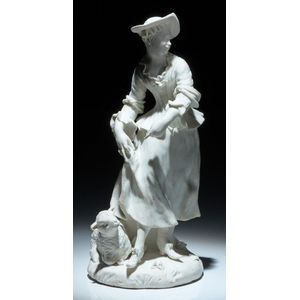Dancing Shepherdess Porcelain Figure with Lamb, Derby, c. 1760
A Derby biscuit porcelain figure of a dancing shepherdess, her head turned slightly away and skirts lifted as if to dance, with attandent lamb to her side, on mounded naturalistic base, circa 1760. Height 18.5 cm. Hole to back of base for bocage. Provenance: The Robin Barkla collection
You must be a subscriber, and be logged in to view price and dealer details.
Subscribe Now to view actual auction price for this item
When you subscribe, you have the option of setting the currency in which to display prices to $Au, $US, $NZ or Stg.
This item has been sold, and the description, image and price are for reference purposes only.
- Bocage - The name given to floral and leaf decoration usually surrounding the main subject in ceramic figures and groups, commonly on 18th century porcelain from the Derby, Bow and Minton works.
- Circa - A Latin term meaning 'about', often used in the antique trade to give an approximate date for the piece, usually considered to be five years on either side of the circa year. Thus, circa 1900 means the piece was made about 1900, probably between 1895 and 1905. The expression is sometimes abbreviated to c.1900.
- Biscuit Porcelain - Biscuit porcelain refers to unglazed, white porcelain that has been fired at a high temperature to harden the material and make it suitable for painting or glazing. The term "biscuit" comes from the French word for "unbaked," referring to the fact that the porcelain has not yet been glazed. The porcelain's firing process is done at very high temperatures and requires good quality of kaolin which is one of the material used to make porcelain.
This item has been included into following indexes:
